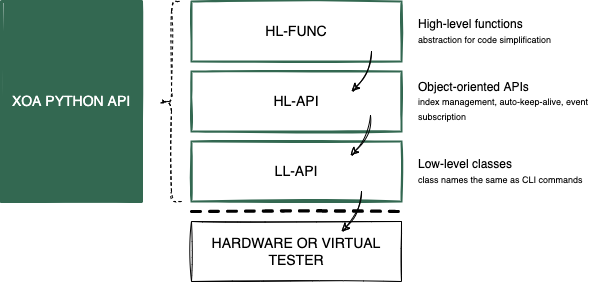API Structure
XOA Python API consists of three layers on top of the Xena proprietary binary API, as shown below.
High-level Functions (HL-FUNC) provides high-level abstraction functions
High-Level API (HL-API) provides object-oriented APIs.
Low-Level API (LL-API) provides low-level class.

XOA Python API Stack View
Descriptions of each layer (from bottom to top) are shown below.
Low-Level API
LL-API is the bottom layer containing low-level command classes that convert human-readable parameters to and from binary data to communicate testers. The names of the low-level command classes are the same as the the CLI commands in XOA CLI. This makes it easy for you to understand and use LL-API if you are already familiar with XOA CLI.
See also
Read more about Low-Level API.
High-Level API
On top of LL-API’s command clases, HL-API provides object-oriented APIs and lets you quickly develop scripts or programs in an object-oriented fashion with explicit definition of commands of different tester, module, port types.
In addition, the HL-API layer provides functionalities such as:
See also
Read more about High-Level API.
High-Level Functions
HL-FUNC provides high-level abstraction functions on top of the object-oriented APIs in HL-API, aiming to help you simplify code logics and increase readability and maintainability. HL-FUNC consists of sub-libraries where functions are grouped based on functionalities, such as ANLT. Complex operation sequences are wrapped inside high-level functions, e.g. initiating link training, reserving ports, etc.
See also
Read more about High-Level Functions.